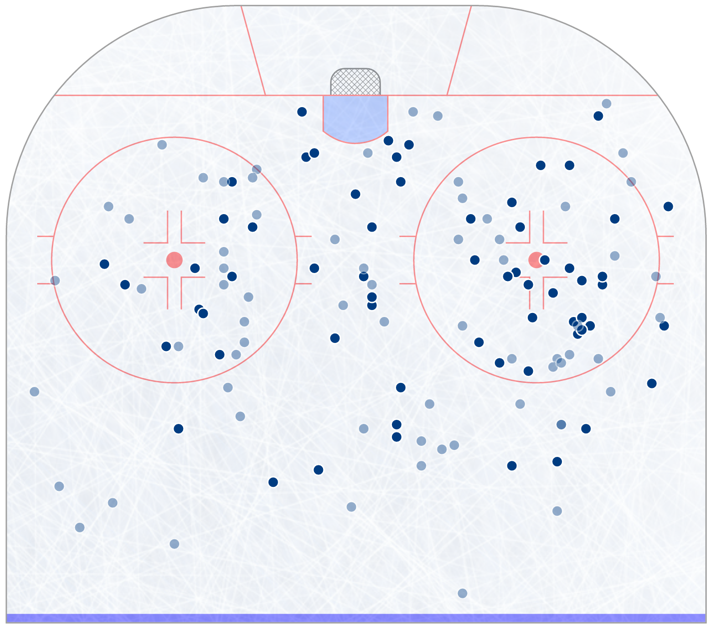Burtch: Nazem Kadri‘s early-season scoring drought with the Leafs is reaching epic proportions. He ranks 470th in the NHL in shooting percentage, dead-last amongst qualified skaters who have scored at least one goal, at 1.2 per cent.
This is largely because he ranks third in the league in shots with 81.
In this situation, because the idea of a shooter being THIS unlucky for THIS many attempts seems so implausible to most observers, we assume it’s because of something the shooter is doing wrong. Even if we haven’t actually observed him doing anything wrong, we will convince ourselves (and others) that he must be, because otherwise the shots would be going in.
It actually is NOT impossible for a shooter to go this cold. In fact, it is less rare than most observers probably think. The probability of a career 12 per cent shooter scoring on only one of 81 shots is about one in 2,500.
On the surface that seems like an extremely rare event, until you consider that many shooters fire over 120 shots in a year. That would amount to around 40 distinct samples of 80 shots (1-80, 2-81, 3-82, etc.).
So while Kadri’s run of bad luck is unfortunate and unlikely, it is not by any means unprecedented. For example in Phil Kessel‘s first year in Toronto (2009-10) he had a stretch of 73 shots where he only scored one goal between Dec 16, 2009 and January 18, 2010. He still managed to score 30 goals in 70 games that season.
That same year Henrik Zetterberg had a stretch of one goal on 75 shots for the Red Wings from Nov 18, 2009 to Jan 14, 2010. In 2012-13 Zetterberg had two distinct stretches of 73 and 65 shots where he only scored once in each. In 2013-14 Daniel Sedin had one goal on 81 shots from January 1 through April 12 of 2014. It obviously isn’t a commonplace occurrence, but good scorers struggle at various points in their careers.
The below graphic shows where Kadri’s shots have been coming from. Faded dots represent shots that missed the net or were blocked, bold dots represent shots on net.

In looking at SportlogIQ data for any more nuanced reasons for the dip, we can assess the fact that of Kadri’s 81 shots, nine have come from the low slot high danger area for goal scoring, eight have come from the high slot, and a further 19 have come from the medium danger zone that extends from the goal crease to the faceoff dots and top of the circles. That would account for 36 of his 81 shots on goal (44 per cent) as either high or medium danger attempts.
It seems unlikely that his shot locations are the issue, as the average NHL shooter will score on over 10 per cent of their shots from those locations — which means we would expect Kadri to have generated at least three more goals from his shot selection alone. So the issue at hand probably isn’t where Kadri is shooting from, but there might be other factors to consider.
Berkshire: Kadri’s an interesting case, especially considering he plays in the most scrutinized market in the NHL. As you can see from the shot location data above, Kadri is getting lots of good looks from scoring areas, with clusters in both circles, close to the crease, and between the hash marks.
According to Sportslogiq data, Kadri is currently producing the 10th-most scoring chances per 20 minutes played in the NHL, so there’s definitely no problem with his shot selection. One idea I’ve heard floated is that Kadri has never shot at this volume before, and it may take some getting used to for him. It’s true that he has nearly doubled his shot rate in all situations compared to the previous four years, up to 4.59 shots on net per 20 minutes played from 2.47, but I don’t think that’s a huge factor, simply because he’s getting to the areas he needs to.
One variable that’s been extremely hard to account for in years past is pre-shot movement. We know that one of the largest factors that can complicate life for NHL goaltenders is when shots occur immediately off of a rebound or pass that requires them to track the puck and move laterally.
Evidence has been shown through work such as Ken Krzywicki’s examination of shot quality in 2010, Stephen Valiquette’s analysis of Royal Road passes, and analysis of Passing Project data collected over the past two years by Ryan Stimson, that shooting percentages on shots requiring lateral movement by goaltenders can be over 30 per cent and increases as the angle they have to push through grows. The decrease in time available to push and meet the puck in a set position along with the fact that lateral motion forces goaltenders to open up holes for shots to pass through, combine to make this a key feature on any scoring chance.
If we want to get a sense of this we can look at where Kadri’s teammates have been hitting him with passes, and compare that to another high volume shooter. It’s clear from this breakdown that most of the passes Kadri receives are pretty high up in the offensive zone, but he is receiving some in the slot. If we want to be a little generous, he has received 32 successful passes into the slot area this year, even if 11 of them were on his backhand.
The question then becomes, how does that compare to other high volume shooters? It may be a little bit unfair, but let’s compare him to Alex Ovechkin, who has nine goals on 92 shots this season. Ovechkin is possibly the greatest pure goal scorer of all time, and he’s excellent at getting lost behind defenders, leaving himself open for quick shots. No one would expect Kadri to score like Ovechkin, but right now in terms of shots on net, they’re comparable.
Ovechkin is currently tied for second in the NHL in scoring chances, behind only his countryman Vladimir Tarasenko, but what we can also see is the rate at which his shot attempts are being set up by a dangerous pass is much higher than Kadri. Not every successful pass to the slot is destined to be a shot on goal, but it is fair to say that the more of them you’re getting, the more likely you are to get scoring chances, and the higher quality those chances are.
Kadri doesn’t have the release that Ovechkin does, so even if you were to give him Nicklas Backstrom, you wouldn’t expect him to score like Ovechkin. When you add in the comparable lack of pre-shot movement in Kadri’s scoring chance generation this likely explains some of the discrepancy between their finishing ability so far this season.
There is definitely some random noise involved in Kadri’s lack of goals so far, but as is almost always the case with an outlier this big, there are factors other than just luck involved.











